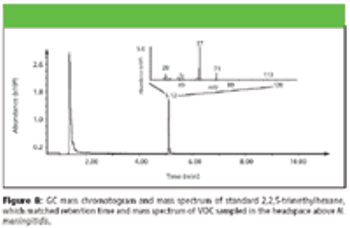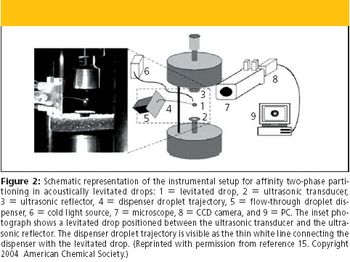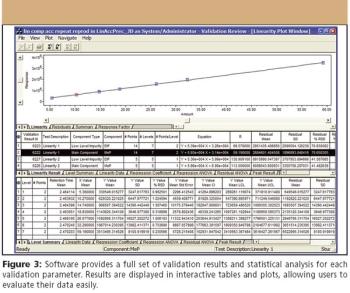
LCGC North America
Check valves are the number one problem area for most LC pumps.

LCGC North America
Check valves are the number one problem area for most LC pumps.

LCGC North America
A method for the identification of key volatile organic compound (VOC) markers associated with infection by Neisseria meningitidis bacteria by gas chromatography–mass spectrometry (GC–MS) was developed. Headspace samples of bacterial VOCs were trapped on triple-sorbent bed tubes and then thermally desorbed into a laboratory GC–MS system for separation. Identification was carried out by comparison of GC retention time and electron ionization mass spectra to the National Institute of Standards and Technology (NIST) database. Further confirmation was obtained by GC–MS of known standard chemicals. A total of 75 VOCs were detected, five of which can be considered key VOC markers for Neisseria meningitidis. These peaks were identified as 1,2-dimethylcyclopropane, 2-methylpropanal, methacrolein, N-2-dimethyl-1-propanamine, and 3-methylbutanal by the NIST database.

LCGC North America
Purification of synthetic, natural and biological compounds in any quantity usually requires the use of preparative HPLC.

LCGC North America
Definitions, however meticulously crafted, can give the meaning of terms with scrupulous clarity, but often fail to tell us how to apply them. Such definitions are descriptions that dictate usage but stop well short of the sense and purpose that many of us turn to them for.

LCGC North America
Protein unfolding and aggregation can be serious considerations when designing laboratory and preparative chromatographic purification steps. This problem has been studied most thoroughly within the contexts of reversed-phase chromatography and hydrophobic interaction chromatography. However, there are currently no robust methods for resin selection capable of predicting adsorbed-phase protein stability as a function of amino acid sequence, secondary or tertiary structure, or resin characteristics.

LCGC North America
LECO Corporation (St. Joseph, Missouri) recently opened a global support center at its headquarters to serve domestic and international customers. The building will house its service, customer training, and consumables departments. An auditorium, training rooms, cafeteria, and restrooms have been designed exclusively for customers attending training classes. Up-to-date technology has been installed to ensure service and training needs for all customers are met quickly and efficiently.

LCGC North America
Liquid-liquid extraction (LLE) is among the most widely used sample preparation methods. In this month's installment of "Sample Prep Perspectives," Ron Majors discusses newer LLE approaches that offer significant advantages over classical methods. The miniaturization of LLE has resulted in solvent and time savings, improved automation possibilities, and faster sample preparation. The techniques of single-drop microextraction, extraction in levitated droplets, flow injection-, membrane-based-, and solid-supported extractions are reviewed. Often, these techniques use the same immiscible solvent pairs of conventional LLE.

LCGC North America
This article describes a software solution for automating the chromatographic method validation process starting from experimental planning, data acquisition and processing, through final report generation in a seamless manner. All experimental planning and calculations are accomplished within the chromatography data software and, thus, are structurally validated, secure, and audit trailed. Highlights of the software are provided, including benefits to the analyst. The analysis of important method validation characteristics such as linearity, accuracy, and precision is automated. These characteristics and their acceptance criteria can be captured in a method template, which adheres to the company's standard operating procedure. This template method can then be used repeatedly by other scientists in the organization, hence, eliminating the need to create a new experimental plan each time a new validation is conducted.